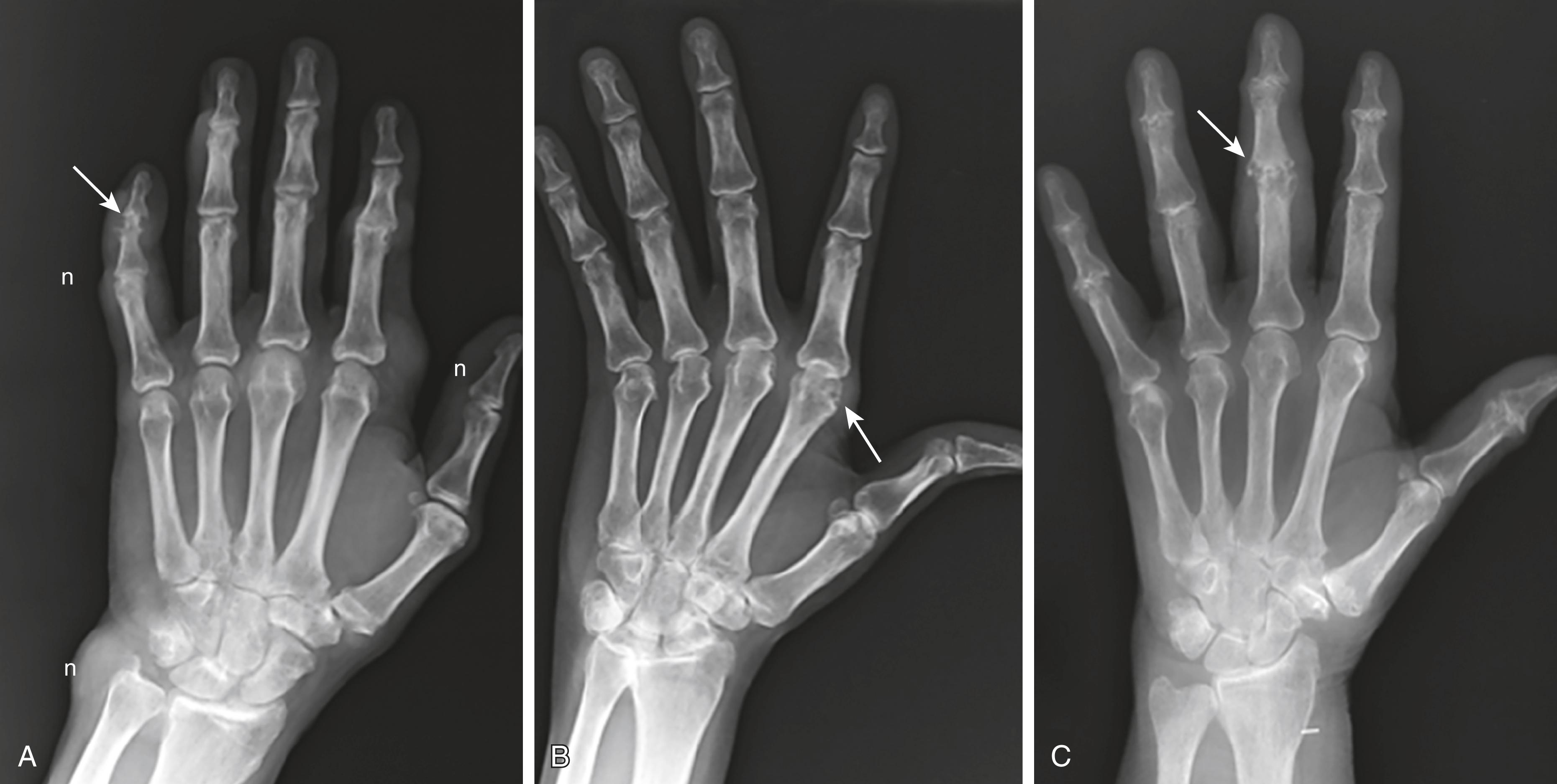Physical Address
304 North Cardinal St.
Dorchester Center, MA 02124
Advanced rheumatic disorders usually can be well characterized by conventional imaging. However, the development of new therapeutic alternatives for the inflammatory arthritides, so-called disease-modifying antirheumatic drugs (DMARDs), and chondroprotective strategies for osteoarthrosis require methods to diagnose these diseases at an earlier stage, characterize the degree of inflammation, and provide a useful metric to assess therapeutic response ( Chapters 28 and 29 ). Indeed, it has become necessary to assess for possible joint and soft tissue abnormalities before irreversible tissue damage and when the radiographic findings are not yet abnormal. Fortunately, the requirement to achieve earlier diagnosis has paralleled advances in imaging. Ultrasonography and magnetic resonance imaging (MRI) have largely supplanted conventional radiographic evaluation in the imaging evaluation of patients with suspected rheumatologic disorders and negative radiographs. The term molecular imaging has been applied, particularly in the case of MRI and positron emission tomography (PET), inasmuch as these modalities reflect local tissue environment or metabolic activity.
Radiographs are projection images. To detect an abnormality, it may be necessary to view a joint or other structure at a specific angle. For instance, subtle erosions in rheumatoid arthritis ( Chapter 243 ) may be apparent only when viewed tangentially, as opposed to en face . Most radiographic evaluations contain at least two orthogonal projections. The addition of an oblique view or other specialized projection may be necessary to address a specific clinical question.
The nature and distribution of joint space narrowing, presence of osteopenia, new bone formation, soft tissue swelling, soft tissue calcification, chondrocalcinosis, presence and nature of erosions, and assessment for joint malalignment may allow a specific diagnosis ( Table 238-1 ), as well as help determine the severity of disease ( Fig. 238-1 ). For instance, the presence of a juxta-articular erosion extending over an adjacent area of slightly hyperdense soft tissue swelling in the setting of normal bone mineralization with maintenance of the adjacent joint space is diagnostic of gout ( Chapter 252 ), in contrast to rheumatoid arthritis. The seronegative arthritides, such as psoriatic arthritis ( Chapter 244 ) and reactive arthritis ( Chapter 254 ), have a characteristic appearance in the small joints of the hand and feet, with a predilection for distal joints, asymmetry, and appositional new bone formation.
| CONDITION | COMMON SITES | DISTRIBUTION | RADIOGRAPHIC FEATURES |
|---|---|---|---|
| Rheumatoid arthritis | Hands: MCP, PIP; wrists: intercarpal, DRUJ, ulnar styloid; feet: fifth MTP; cervical spine (atlantoaxial, apophyseal) | Bilateral, symmetric, polyarticular | Juxta-articular osteopenia, periarticular swelling, subluxations (e.g., ulnar, volar), uniform joint space loss, erosions (bare areas) |
| Osteoarthritis (primary) | Hands (DIP), wrists (basal joint, STT), feet (first MTP), hips (superolateral), knees (medial), spine (discs, facet, or apophyseal, uncovertebral) | Symmetric, weight-bearing joints | Normal or increased density, nonuniform joint space loss, subchondral sclerosis, cysts, bone formation (osteophytes) Spine: disc space narrowing, end plate sclerosis, and bone formation |
| Psoriatic arthritis | Hands (DIP, terminal tufts), feet (IP joints), entheses (calcaneus-plantar, posterior), spine, SI joints | Asymmetric (single ray), polyarticular, segmental (intervertebral, apophyseal) | Normal or increased density, periosteal bone formation, soft tissue swelling, ankylosis (SI joints), thick hyperostosis spine (nonmarginal syndesmophytes), juxta-articular and periarticular erosions |
| Ankylosing spondylitis | Spine, SI joints, fibrous joints (pubic symphysis), entheses (adductor origin), rhizomelic joints (hips, shoulders) | Symmetric, continuous (may affect entire spine: bamboo spine) | Normal or increased density, erosions (spine: squaring, shining corner) with superimposed bone formation (ankylosis: SI, thin [marginal] syndesmophytes) |
| Gout | Feet (first MTP), other damaged joints, elbow, knee, hindfoot | Asymmetric, extensor surfaces (elbow), abnormal joints (e.g., osteoarthritic joints) | Normal joint space, normal or increased density, dense soft tissue nodules (tophi), para-articular and subchondral erosions with bone formation along tophi (overhanging edge) |
| CPPD | Hands (second, third MCP), wrists (radiocarpal, TFC), knees (lateral compartment and patella-femoral, menisci) | Symmetric, fibrocartilaginous joints | Normal or increased density, hypertrophic bone formation, subchondral or periarticular cysts, chondrocalcinosis (hyaline, fibrocartilage), periarticular, peritendinous, periligamentous calcification |
| Infection | Any joint (pyogenic, TB) | Monoarticular (mostly), any joint | Pyogenic: osteopenia (days), joint space widened (early), joint space loss (rapid development), soft tissue swelling, erosions—both sides of joint, sequestra, periostitis TB: joint space and mineralization may be preserved, juxta-articular erosions Spine: disc space loss and end plate erosion |

Radiographs also provide a direct means for needle localization during percutaneous procedures, predominantly joint injections, aspirations, and some biopsies. These procedures are generally performed guided by imaging in real time (fluoroscopy) using short bursts of low-intensity x-rays enhanced through an image intensifier. Injection of joints under fluoroscopic guidance provides a convenient means to ensure intra-articular deposition of the therapeutic agent or for diagnostic aspiration. Intra-articular location is verified by injection of a small amount of a standard iodinated contrast material. Arthrography using fluoroscopic guidance can be used as a primary diagnostic tool, but this application has largely been replaced by intra-articular injection of contrast followed by computed tomography (CT) or MRI.
For some procedures, CT may be preferable, depending on the location of the abnormality. The principal disadvantages of fluoroscopy relate to the use of ionizing radiation and poor soft tissue contrast. The latter becomes important with needle placement near neurovascular structures that may be potentially compromised by poor needle position. CT allows greater control over needle placement at the cost of greater levels of radiation exposure. Ultrasonography has replaced fluoroscopy and CT for a large number of percutaneous procedures. MRI provides another method to guide a variety of procedures without the necessity of ionizing radiation. These options will be discussed in greater detail later.
Become a Clinical Tree membership for Full access and enjoy Unlimited articles
If you are a member. Log in here